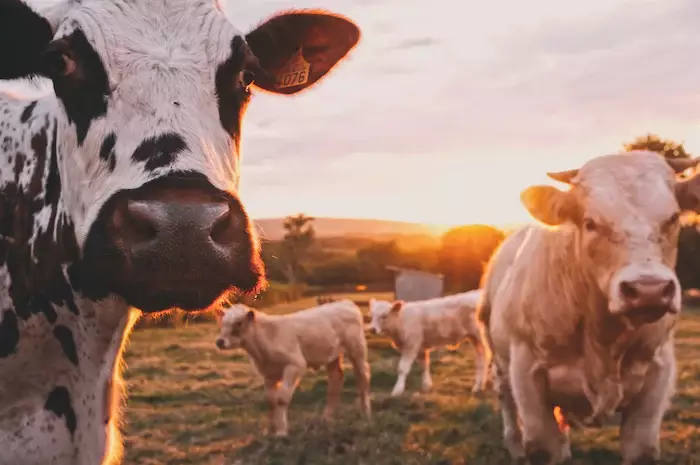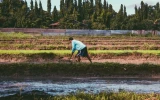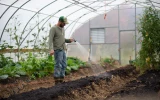The 12 Types of Small-Scale Farming Explained (With Examples)
Small-scale farming is an important part of agriculture that can be done in small backyard gardens. Let's explore the types of small-scale farming, so you can decide which one is best for you.
The types of small-scale farming are organic farming, subsistence farming, agroforestry, aquaponics, permaculture, pastured poultry, crop rotation, intensive gardening, intensive livestock, specialty crops, Community-Supported Agriculture, and vertical farming. Examples include urban farms and backyard gardens.
Organic, subsistence, and agroforestry farming are the three most popular types of small-scale farming. This article will explore these three and the various types of small-scale farming and provide examples of each.
Summary
- The most commonly used types of small-scale farming are organic, subsistence, and agroforestry farming.
- Subsistence farming involves growing basic crops and raising livestock for personal use.
- Agroforestry combines trees and crops to create a sustainable system.
- Companion planting in permaculture can provide nutrients to different types of plants in the same garden plot.
- Aquaponics and specialty crop production both use hydroponic systems to increase yields and quality.

On this page:
12 Types of Small-Scale Farming
Here are the 12 types of small-scale farming, their characteristics, and how they are used in different parts of the world.
1. Organic farming
Organic farming is an agricultural system that focuses on producing food naturally and sustainably, without the use of synthetic fertilizers, pesticides, or other artificial inputs. Organic farming emphasizes soil health and animal welfare, using methods such as crop rotation and composting to improve fertility and reduce the need for external inputs.
One example of organic farming is when someone chooses to practice organic farming because they want to produce food in a way that is good for the environment, animals, and their family. They’ve implemented a variety of practices on their farm, including cover cropping and intercropping.
The farm is managed without the use of synthetic fertilizers and pesticides, and they use natural pest control methods such as companion planting and biological control.
2. Subsistence farming
Subsistence farming is a type of agriculture where farmers grow food crops to meet the needs of their families. This type of farming is often characterized by small plots of land, limited use of technology, and reliance on traditional farming techniques.
An example of subsistence farming is the traditional system of farming in rural India, where farmers rely on monsoon rains and simple tools to grow their crops. These farmers typically grow crops such as millet, rice, and wheat to provide their families with enough food to survive.
3. Agroforestry
Agroforestry is a type of land management that combines trees with crops and/or livestock. This type of land management allows for multiple land uses that can provide economic and environmental benefits. Agroforestry systems can also be used to diversify farming systems, increase water infiltration, and provide habitat and food sources for wildlife.
An example of agroforestry is alley cropping, which is the practice of planting trees, shrubs, and crops in alternating rows. Alley cropping can be used to provide shade and wind protection for crops, provide food and shelter for beneficial insects, and create a living mulch.
4. Aquaponics
Aquaponics is a type of agricultural system that combines raising fish with growing fruits and vegetables. It is an incredibly efficient way to produce food, as the waste from the fish is used to fertilize the plants, and the plants filter the water for the fish.
An example of an aquaponics system is a fish tank connected to a hydroponic system, where the water from the fish tank is pumped up to the hydroponic system and returned to the fish tank after being filtered by the plants. This allows both the fish and the plants to thrive in a symbiotic environment.
5. Permaculture
Permaculture is an ecological design system that can be used to create sustainable, self-sufficient, and regenerative environments. It is based on the principles of caring for the earth, caring for people, and sharing the surplus.
An example of permaculture is the use of companion planting. Companion planting is the practice of growing plants together to support and protect each other. This can include growing different types of vegetables, herbs, and flowers in the same garden plot. By growing different types of plants together, they can provide nutrients to each other and reduce the need for pesticides and fertilizers.

6. Pastured poultry
Pastured poultry is a type of poultry that is raised outdoors on green pasture, instead of in a factory farm or feedlot. This type of poultry is often more expensive than conventionally raised poultry, but it is also healthier and more humane.
For example, at Rainbow Acres Farm, chickens are raised in spacious pastures and fed a special diet of natural grains, insects, and grasses. They are also rotated to fresh pasture every day, providing them with a varied diet and ample space to roam.
7. Crop rotation
Crop rotation is an important sustainable farming practice that is used on small farms to maintain soil fertility and health. By rotating the same or different crops in the same space over time, farmers can reduce the risk of disease, pests, and nutrient depletion.
For example, one year a farmer may plant wheat in a field, and the next year they may plant corn in that same field. This helps to reduce the risk of disease and pest infestations and also helps to restore nutrients in the soil.
8. Intensive gardening
Intensive gardening is a type of gardening that involves growing plants close to one another, often in raised beds. This type of gardening is beneficial for many reasons, including increased yields, reduced space requirements, improved soil health, and reduced water consumption.
An example of intensive gardening is a square-foot garden, in which plants are grown in a 4x4-foot raised bed and spaced at one plant per square foot. This type of gardening helps to make the most of limited space and resources, allowing a gardener to grow a large amount of produce in a relatively small area.
9. Intensive livestock production
Intensive livestock production is a form of small farming that focuses on the production of livestock, such as poultry, pigs, and cows, in a confined environment. The goal of this type of farming is to produce a large number of animals in a small space, using fewer resources.
This type of production is often done in barns, where the animals are kept in smaller pens and have access to a limited amount of space. For example, a small pig farm may have a barn that houses 50 pigs in individual pens, each containing only a few square feet of space.

10. Specialty crop production
Specialty crop production is the cultivation of crops with unique characteristics or qualities. These crops are grown for specific purposes and can be used for food, medicine, or industrial applications.
An example of this is when production often involves the usage of advanced production methods, such as hydroponic systems, to maximize yields and quality. Specialty crops often require more input than traditional crops, such as fertilizers, pesticides, and specialized equipment, and often require more labor.
11. Community Supported Agriculture (CSA)
Community-Supported Agriculture (CSA) is an agricultural production system that distributes the risk of farming between farmers and members of the local community. CSA members receive a weekly box of seasonal produce, meat, eggs, and other products directly from a local farm.
An example of a local CSA is a vegetable farm that offers an organic produce box subscription. The subscription comes with a weekly box filled with freshly harvested produce from the farm as well as weekly emails with recipes featuring the produce in the box.
12. Vertical farming
Vertical farming is an innovative farming technique that uses vertical space to grow crops. It utilizes multi-level hydroponic and aeroponic systems to maximize crop yields. This type of farming requires minimal land, water, and energy, making it an environmentally friendly solution for sustainable food production.
An example of vertical farming is a 12-story vertical farm that produces greens, herbs, and root vegetables for local grocery stores and restaurants. This vertical farm is powered by renewable energy and uses no soil, pesticides, or harmful chemicals.

